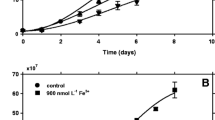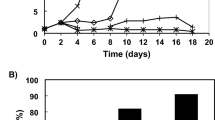Abstract
Algae (and their extracts) are increasingly important for pharmaceutical applications due to the diversity of useful compounds they contain. The genus Fucus contains one of the most studied species, Fucus vesiculosus. The species F. ceranoides differs from the others of the genus by presenting longitudinal air-vesicles and a capacity to survive at low salinities. It is an alga that inhabits the Mondego River estuary (Portugal), at the southern limit of its distribution, and can serve as a role model to understand the effect of a salt gradient on the production of bioactive compounds. We assessed the phenolic content and antioxidant activity of different F. ceranoides extracts (e.g. methanolic, aqueous and polysaccharide) prepared from samples harvested from two different zones to evaluate if the adaptation of F. ceranoides to different salinity levels influenced its chemical composition. The antioxidant activity of the extracts was determined using 1,2-diphenyl-picrylhydrazyl (DPPH) and 2.2-azino-bis (3-ethylbenzothiazoline-6-sulfonic acid) (ABTS) radicals. These assays demonstrated that the methanolic extract of lyophilized F. ceranoides that grew at low salinities was the most bioactive, i.e. DPPH (IC50=50.39 µg/mL) and ABTS (TEAC=2.42). The total phenolic content (Folin-Ciocalteu method) and the methanolic extract of the lyophilized F. ceranoides collected from a low salinity habitat exhibited the highest phenolic content (PGE=49.48 µg/mg of lyophilized extract) amongst those sampled. Thin layer chromatography (TLC) and Fourier transform infrared spectroscopy (FTIR) were used for the identification of compounds in the extracts. This characterization allowed confirmation that the various extracts contained almost the same compounds but with notable quantitative differences. Based on these results, we conclude that there were differences in the quantity of the compounds due to the effect of salinity. The drying methods used were also found to have influenced the quality of the extracted compounds.
Similar content being viewed by others
References
Bäck S, Collins J C, Russell G. 1992. Recruitment of the Baltic flora: the Fucus ceranoides enigma. Botanica Marina, 35(1): 53–59.
Barahona T, Chandia N P, Encinas M V, Matsuhiro B, Zúñiga, EA. 2011. Antioxidant capacity of sulfated polysaccharides from seaweeds: a kinetic approach. Food Hydrocolloids, 25: 529–535.
Beauchamp E. 2012. Effects of UV radiation and salinity on the intertidal macroalgae Palmaria palmata and Ulva lactuca; effects on photosynthetic performance, growth and pigments. The Plymouth Student Scientist, 5(1): 3–22.
Blois M S. 1958. Antioxidant determinations by the use of a stable free radical. Nature, 26(4617): 1 199–2 000.
Brawley S H, Johnson L E. 1992. Gametogenesis, gametes and zygotes: an ecological perspective on sexual reproduction in the algae. British Phycological Journal, 27(3): 233–252.
Cumashi A, Ushakova N A, Preobrazhenskaya M E, D–Incecco A, Piccoli A, Totani L, Ninari N, Morozevich G E, Berman A E, Bilan M I, Usov A I, Ustyuzhanina N E, Grachev A A, Sanderson C J, Kelly M, Rabinovich G A, Iacobelli S, Nifantiev N E. 2007. A comparative study of the anti-inflammatory, anticoagulant, antiangiogenic, and antiadhesive activities of nine different fucoidans from brown seaweeds. Glycobiology, 17(5): 541–552.
de Carvalho L G. 2013. Avaliação do Potencial Biotecnológico de Micro E Macroalgas da Flora Portuguesa. University of Coimbra, Coimbra, Portugal. (in Portuguese)
Fitton J H, Stringer D N, Karpiniec S S. 2015. Therapies from fucoidan: an update. Marine Drugs, 13(9): 5 920–5 946.
Imbs T I, Ermakova S P, Fedoreyev S A, Anastyuk S D, Zvyagintseva T N. 2013. Isolation of fucoxanthin and highly unsaturated monogalactosyldiacylglycerol from brown alga Fucus evanescens C Agardh and in vitro investigation of their antitumor activity. Marine Biotechnology, 15(5): 606–612.
Jeffrey S W, Humphrey G F. 1975. New spectrophotometric equations for determining chlorophylls a, b, c 1 and c 2 in higher plants, algae and natural phytoplankton. Biochemie und Physiologie der Pflanzen, 167(2): 191–194.
Jeffrey S W. 1972. Preparation and some properties of crystalline chlorophyll c 1 and c 2 from marine algae. Biochimica et Biophysica Acta (BBA) - General Subjects, 279(1): 15–33.
Khfaji A K, Norton T A. 1979. The effects of salinity on the distribution of Fucus ceranoides. Estuarine and Coastal Marine Science, 8(5): 433–439.
Koivikko R, Loponen J, Honkanen T, Jormalainen V. 2005. Contents of soluble, cell-wall-bound and exuded phlorotannins in the brown alga Fucus vesiculosus, with implications on their ecological functions. Journal of Chemical Ecology, 31(1): 195–212.
Koivikko R. 2008. Brown Algal Phlorotannins - Improving and Applying Chemical Methods. University of Turku, Turku, Finland. 61p.
Mikami K, Hosokawa M. 2013. Biosynthetic pathway and health benefits of fucoxanthin, an algae-specific xanthophyll in brown seaweeds. International Journal of Molecular Sciences, 14(7): 13 763–13 781.
Peng J, Yuan J P, Wu C F, Wang J H. 2011. Fucoxanthin, a marine carotenoid present in brown seaweeds and diatoms: Metabolism and bioactivities relevant to human health. Marine Drugs, 9(10): 1 806–1 828.
Pereira L, Gheda S F, Ribeiro-Claro P J A. 2013. Analysis by vibrational spectroscopy of seaweed polysaccharides with potential use in food, pharmaceutical, and cosmetic industries. International Journal of Carbohydrate Chemistry, 2013: Article ID 537202.
Pereira L, Ribeiro-Claro P J A. 2015. Analysis by vibrational spectroscopy of seaweed with potential use in food, pharmaceutical and cosmetic industries. In: Pereira L, Patricio J, Neto J M eds. Marine Algae - Biodiversity, Taxonomy, Environmental Assessment, and Biotechnology. Science Publishers, an Imprint of CRC Press/ Taylor & Francis Group, Boca Raton, FL.
Pereira L. 2016. Edible Seaweeds of the World. CRC Press, Boca Raton, FL. 448pp.
Pereira L. 2018. Therapeutic and Nutritional Uses of Algae. CRC Press, Boca Raton, FL. 640pp.
Pielesz A, Machnicka A, Sarna E. 2011. Antibacterial activity and scanning electron microscopy (SEM) examination of alginate-based films and wound dressings. Ecological Chemistry and Engineering. S, 18(2): 197–210.
Re R, Pellegrini N, Proteggente A, Pannala A, Yang M, Rice-Evans C. 1999. Antioxidant activity applying an improved ABTS radical cation decolorization assay. Free Radical Biology and Medicine, 26(9–10): 1 231–1 237.
Rodriguez-Jasso R M, Mussatto S I, Pastrana L, Aguilar C N, Teixeira J A. 2014. Chemical composition and antioxidant activity of sulphated polysaccharides extracted from Fucus vesiculosus using different hydrothermal processes. Chemical Papers, 68(2): 203–209.
Rupérez P, Ahrazem O, Leal A J. 2002. Potential antioxidant capacity of sulfated polysaccharides from the edible marine brown seaweed Fucus vesiculosus. Journal of Agricultural and Food Chemistry, 50(4): 840–845.
Serrão E A, Brawley S H, Hedman J, Kautsky L, Samuelsson G. 1999. Reproductive success of Fucus vesiculosus (Phaeophyceae) in the Baltic Sea. Journal of Phycology, 35(2): 254–269.
Singh I P, Bharate S B. 2006. Phloroglucinol compounds of natural origin. Natural Product Reports, 23(4): 558–591.
Stengel D B, Connan S, Popper Z A. 2001. Algal chemodiversity and bioactivity: sources of natural variability and implications for commercial application. Biotechnology Advances, 29(5): 483–501.
Tierney M S, Soler-vila A, Croft A K, Hayes M. 2013. Antioxidant activity of the brown macroalgae Fucus spiralis Linnaeus harvested from the West coast of Ireland. Current Research Journal of Biological Sciences, 5(3): 81–90.
Wright S W, Jeffrey S W. 1987. Fucoxanthin pigment markers of marine phytoplankton analysed by HPLC and HPTLC. Marine Ecology Progress Series, 38: 259–266.
Xia S, Wang K, Wan L L, Li A F, Hu Q, Zhang C W. 2013. Production, characterization, and antioxidant activity of fucoxanthin from the marine diatom Odontella aurita. Marine Drugs, 11(7): 2 667–2 681.
Yip W H, Lim S J, Mustapha W A W, Maskat M Y, Said M. 2014. Characterisation and stability of pigments extracted from Sargassum binderi obtained from Semporna, Sabah. Sains Malaysiana, 43(9): 1 345–1 354.
Zubia M, Fabre M S, Kerjean V, Le Lann K, Stiger-Pouvreau V, Fauchon M, Deslandes E. 2009. Antioxidant and antitumoural activities of some Phaeophyta from Brittany coasts. Food Chemistry, 116(3): 693–701.
Acknowledgment
This work had the support of Fundação para a Ciência e Tecnologia (FCT), through the strategic project UID/MAR/04292/2013 granted to MARE. Also received funding from European Structural & Investment Funds through the COMPETE Programme and from National Funds through FCT-Fundação para a Ciência e a Tecnologia under the Programme (No. SAICTPAC/0019/2015).
Author information
Authors and Affiliations
Corresponding author
Rights and permissions
About this article
Cite this article
Cotas, J., Figueirinha, A., Pereira, L. et al. The effect of salinity on Fucus ceranoides (Ochrophyta, Phaeophyceae) in the Mondego River (Portugal). J. Ocean. Limnol. 37, 881–891 (2019). https://doi.org/10.1007/s00343-019-8111-3
Received:
Accepted:
Published:
Issue Date:
DOI: https://doi.org/10.1007/s00343-019-8111-3




